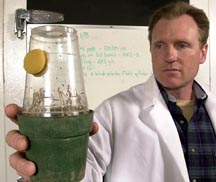 Purdue News
Purdue News
 Purdue News
Purdue News

|
|
March 2001 Hessian fly genomics research will benefit
|

|
But the fly's genetic tricks may be its undoing because Purdue University entomologist Jeff Stuart plans to use that genetic information against it to prevent future outbreaks of the pest.
Major infestations of the Hessian fly don’t happen often, but when they do occur they can be devastating. For example, 1989 outbreaks in Texas and South Dakota caused an estimated $15 million and $30 million in damage respectively. Stuart says the fly is nearly ubiquitous.
After an area has been infested, farmers try to stop future outbreaks by switching wheat varieties and hoping this stops the fly from returning the next year. It's a hit-or-miss approach.
Stuart says it is not completely known how resistant varieties of wheat stop the fly, but it appears that the resistant wheat plants wall off living cells from the insect. This causes the Hessian fly larvae to starve.
"Almost everywhere one grows wheat you’ll find this insect, with the possible exceptions of Australia and Japan," he says. "The fly is out there, and when environmental conditions are just right, such as a cool, wet spring and if you have a field that had some volunteer wheat during the summer, the fly populations can take off and become a real problem."
If the Hessian fly couldn't mutate to get around wheat's defenses, the insect would die out because they can't feed on any other plant. Scientists can't even raise them in the laboratory on artificial diets. However, every time the Hessian fly mutates and develops a new way to invade wheat, wheat breeders have been able to identify and incorporate new Hessian fly resistance genes in new cultivars of wheat, and the battle between plant and animal begins anew.
When the mosquito-like Hessian fly bites into a wheat plant, it releases a myriad of molecules in its saliva. Some of these molecules are the products produced from genes called "avirulence genes" in the fly. Wheat plants that are resistant to the fly have resistance genes that establish a sort of chemical detection system that can detect one of these molecules. This interaction between avirulence genes molecules and the resistance gene molecules initiates a cascade of biochemical events that prevent the fly from being able to feed on the wheat plant.
Eventually a fly with slightly different genetics comes along that lacks that particular avirulence gene product in its saliva. This fly is able to overcome the resistant wheat plant's detection system.
"Once the virulence genes are mapped in the Hessian fly, we plan to use molecular markers that are tightly linked to one gene to clone it. This will be the first time an avirulence gene is cloned from an insect," Stuart says. "That would give us a complete picture in the laboratory of how the resistance process works."
The relationship between the crop’s resistance and the fly’s mutations is so close that biologists refer to it as a "gene-for-gene" relationship.
"For every resistance gene in wheat that can stop the fly, there’s a complementary avirulence gene in the fly that can overcome the resistance," Stuart says.
No one has yet cloned either a Hessian fly resistance gene in wheat or the corresponding genes in insects, but Stuart is hoping to map and clone the genes that play a role in the battle. This information would not only improve the resistance in wheat, but also could lead to the development of new diagnostic tools to help wheat farmers know which resistant varieties of wheat to plant to overcome the infestation.
Because it would be the first time that avirulence genes have been cloned in an insect, it also would provide clues to the genetics of other insects.
"We are taking a genomics approach to the Hessian fly gene and the molecules it produces," Stuart says. "We are mapping the virulence genes in the fly. Then we will try to identify the molecules in wheat that interact with the Hessian fly molecules. Then we can use that knowledge to initiate the resistance reaction and find the genes in wheat."
This backward approach to identifying the resistance genes in wheat is preferred because of the enormous size of the wheat genome.
"The wheat genome is huge, so it’s difficult to do map-based cloning in wheat," Stuart says. "But the Hessian fly has the smallest known genome of any insect. Its genome is roughly half the size of the Drosophila genome, which is the fruit fly that scientists often use in genetic experiments."
Source: Jeff Stuart, (765) 494-4561; jeff_stuart@entm.purdue.edu
Writer: Steve Tally, (765) 494-9809; tally@aes.purdue.edu
Purdue News Service: (765) 494-2096; purduenews@purdue.edu
Related Web sites:
Purdue Genomics backgrounder
Purdue Biotechnology backgrounder
Purdue Office of Agricultural Research Programs
Purdue genomics initiative
PHOTO CAPTION:
Purdue University entomologist Jeff Stuart examines a collection of Hessian flies in his laboratory. Stuart is mapping and cloning the genes that the fly uses to infest wheat in order to reduce future infestations. (Purdue Department of Agricultural Communications photo by Tom Campbell.)
 To the Purdue News and Photos Page
To the Purdue News and Photos Page